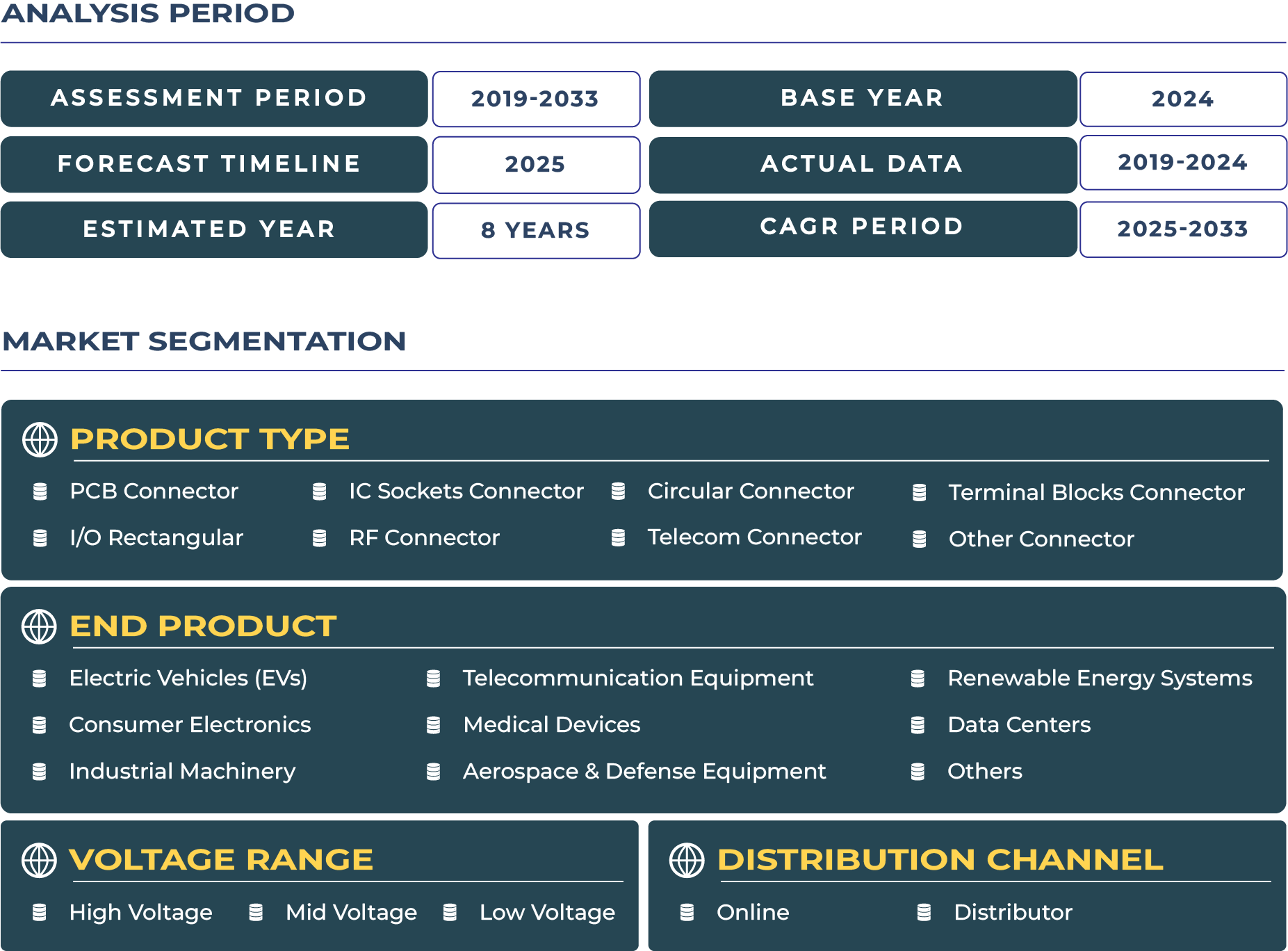Report Format:
![]()
![]() |
Pages: 110+
|
Pages: 110+
US Connector Market Outlook
The US connector market is undergoing a period of unprecedented acceleration, fueled by a confluence of transformative technologies and strategic national investments. With the market expected to register a 7.7% CAGR during the forecast period, as per David Gomes, Manager – Semiconductor, the surge is underpinned by massive infrastructure developments in AI data centers, electric vehicle (EV) platforms, grid modernization, and renewable energy expansion. In 2024 alone, investments in data center infrastructure surpassed $31.5 billion, and projections suggest that figure could eclipse $1 trillion within the decade. These hyperscale facilities demand high-density, high-efficiency connectors to manage workloads exceeding 500 MW per site—driven by AI accelerators, liquid cooling, and fiber-optic backbones. Companies like Microsoft, AWS, and Google have committed record capital outlays, with Microsoft alone planning $80 billion in AI-based infrastructure by 2025.
The connector market is tightly interwoven with the explosive growth of EVs and the broader electrification agenda. With $208.8 billion in EV-related projects incentivized through the Inflation Reduction Act (IRA), automakers are reshaping sourcing strategies to localize battery production and optimize charging architectures. Connector components are essential to everything from battery cell interconnects to onboard high-voltage junctions and thermal management systems. Tesla, Ford, Rivian, and Hyundai are reengineering their electrical subsystems to qualify for IRA tax credits and reduce foreign dependency. As EV manufacturing scales toward 18 million units by 2028, annual connector demand in this segment alone is poised to double.
Meanwhile, renewable energy systems are also generating tailwinds. The U.S. Energy Information Administration forecasts solar generation to grow 31% YoY in 2025, overtaking hydroelectric output for the first time. As solar farms, offshore wind, and nuclear microgrids proliferate, advanced connector solutions are becoming vital to accommodate bidirectional energy flows, dynamic line ratings, and modular grid architectures. Avangrid’s $20 billion plan to modernize the U.S. grid underscores the need for resilient and scalable connector solutions, especially as the Department of Energy's GRIP program injects further momentum into interregional transmission upgrades.
However, the industry is not without constraints. Geopolitical tensions and protectionist trade policies are driving up costs for imported connector components. Tesla still relies on 20%–25% of foreign parts, leaving it vulnerable to pricing volatility due to tariff fluctuations. Furthermore, shortages in critical minerals such as lithium and graphite are prompting stakeholders to secure domestic mining rights and vertically integrate supply chains. Regulatory inconsistencies between states, particularly in permitting and energy policy, also create friction in deployment timelines. FERC's new framework for streamlining transmission expansion, while necessary for decarbonization, faces opposition in several Republican-led states. The fragmented landscape complicates infrastructure alignment and adds uncertainty for OEMs and developers alike.
To navigate these challenges, connector manufacturers are doubling down on innovation. ESG-aligned product development—including the use of recyclable materials, halogen-free insulation, and low-loss conductive alloys—is becoming standard. AI-driven manufacturing optimization and real-time diagnostics in connector performance are improving uptime in mission-critical installations. Industry collaborations are rising, with companies such as Nvidia and Intel working closely with connector vendors to co-develop high-speed solutions tailored to next-gen AI servers. Similarly, public-private alliances like those spearheaded by Avangrid and the DOE are fostering a fertile environment for market innovation and job creation, with over 75,000 new skilled roles anticipated in the next five years.
Looking forward, the US connector market is strategically positioned to serve as the nerve system of America’s clean energy, digital, and transportation revolutions. With the federal government targeting a fivefold increase in interregional power transmission by 2030, the demand for high-reliability connector solutions will continue to scale. The future of connectors lies in their ability to bridge intelligence, energy, and automation. For stakeholders—from investors and OEMs to policymakers and utilities—the imperative is clear: secure, sustainable, and high-performance connectors will be fundamental to national progress in the decade ahead.
Authors: David Gomes (Manager – Semiconductor)
*Research Methodology: This report is based on DataCube’s proprietary 3-stage forecasting model, combining primary research, secondary data triangulation, and expert validation. [Learn more]
US Connector Market Scope







